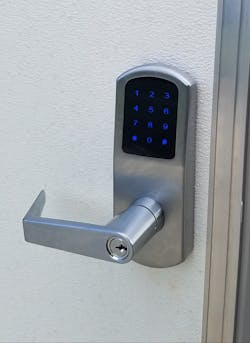PDQ’s Standout Stand-Alone Locks
We at Locksmith Ledger love keys and view with some dismay their disappearance from the physical-security landscape. But, as the saying goes, “you don’t need a weatherman to know which way the wind blows.” That is to say, the disappearance of mechanical keys is more than a trend — it’s the future, and the future is now.
But locks are just as critical to physical security now, perhaps more so, so selling, installing and repairing locks remains an essential trade. Only your lock might not operate with a key anymore. This is the case with the pdqSMART-stp series of stand-alone smart locks.
A recent installation of such a lock, the GTS-STP heavy-duty cylindrical lock, was performed on a large corrugated-steel building that’s used to store and work on antique cars. The customer wanted to use his smartphone for access.
On this project, we started with a Schlage SC C six-pin cylinder. PDQ offers a wide selection of cylinder options, and the pdqSMART-stp can be fitted with virtually any cylinder you wish.
Up to 100 users can be programmed into the lock, but only a limited number of individuals required access, so this project would use only a couple of the input options available. The owner’s preferred method was by using his smartphone. PDQ has keyfobs, and we set the door up with these as well. The fobs are Bluetooth, highly secure and enrolled individually into the lock through the pdqSMART-stp app.
I also programmed a PIN into the lock, because the owner is familiar with these, and he can change the PIN as often as he wants.
If the owner decides that he wants to program the lock from a distance farther than the lock’s Bluetooth range (such as, in another part of the world), it’s necessary to connect the lock to the internet through a PDQ Ethernet Bridge. The owner then can communicate with the lock anywhere there’s internet access.
Setting It Up
I opted to preprogram the lock before installing it, and what was amazing was I hardly touched the lock throughout the entire process, because the app did it all.
Setting up the necessary account took about 5 minutes, and getting the unit to unlock by using the smartphone took another few moments. After you get used to the user interface, programming is straightforward and can be handled by anyone who has minimal experience with smartphones and apps. Regular housekeeping chores on the lock don’t require a callback or a service call. Maybe a phone call the first few times. Then, if he wants, the owner can take off the training wheels and assume full control.
As a matter of fact, installing the PDQ breaks tradition followed by many installers, which is to open the box, take out the product and throw away the carton and instructions before starting the installation. All the instructions for the pdqSMART-stp lock, except the drilling template, are on the app.
Then, all you do is find the device’s QR sticker (in the carton or on the unit itself), create an account and install the app.
My mind was blown: No more hours of pumping numbers into the door unit with an expensive progammer hanging off a delicate two-foot cord were required.
The PDQ lock has a nice design, and it follows many of the conventions regarding shape and size for stand-alone locks.
Drilling into the door is minimal, particularly if you retrofit from a cylindrical lockset. The GTS-STP is Grade 1 and available only in 2-3/4-inch backset.
The keypad is a touchscreen, so it doesn’t invite vandalism and illuminates if required.
PDQ Q&A
We contacted PDQ’s Kim Wanamaker, vice president of marketing, and Ken Rinehart, SMART technical support specialist, to dig deeper.
Locksmith Ledger: Please tell us about your company’s range of products.
Kim Wanamaker: We offer a complete range of architectural door hardware, including BHMA-certified mortise and cylindrical locks, deadbolts, electrified locks, keys and keying system services, exit devices, exit device trims, door closers, hinges, flat goods and general hardware.
We also offer a complete line of wireless access control products, including wireless mobile-managed stand-alone smart locks and networked access control.
LL: Where are your products manufactured?
KW: Over 50 percent of our products are manufactured and assembled in the USA (at their Lancaster, Pennsylvania, headquarters), including locks, exit device trim and access control.
LL: What makes your products stand out?
KW: Our pdqSMART wireless mobile-managed access control products are simple, secure, flexible and smart. Hardware and software are integrated and come from one company. That means customers don’t get the runaround when there are hardware or software operability issues.
We also offer a complete family of wireless mobile-managed stand-alone devices to meet all of a facility’s application requirements: Grade 1 mortise, Grade 1 and Grade 2 cylindrical locks, interconnected locks, heavy-duty deadbolts and heavy-duty exit device trim.
With five credential possibilities, you can operate pdqSMART stand-alone locks however you feel comfortable.
Devices are quick and easy to install and perfect for retrofit applications. They all fit standard door preps. Because they’re wireless, the installation time is slashed, and future flexibility is built in. Costs are further reduced because no on-site software or IT support is required. All software is in the cloud and always accessible 24/7.
pdqSMART locks use Bluetooth Low Energy (BLE) 4.2 communications, [so] pdqSMART will operate locks even when there is a power outage or the internet goes down, unlike products that communicate via Wi-Fi or Z-Wave. pdqSMART locks also are cybersecure: They use patented end-to-end AES 128-bit cypher chain-blocking encryption. The locks can be quickly and easily upgraded to a networked device without a hardware change. Just download new firmware, and the lock is networked.
Finally, pdqSMART offers a wide selection of levers and architectural finishes to match your décor. All devices have key bypass with 22 keyways plus restricted, high security and UL 437. Conventional, SFIC, Schlage LFIC, high-security and UL 437 cylinders are available.
LL: How can a locksmith buy your products?
KW: PDQ products can be purchased through distributors and wholesalers across the United States.
LL: What features does the app provide?
KW: Our smartphone app makes it easy to add or delete users. The app also features an audit trail that displays all activity — who, when and where. You can schedule access for regular visitors, such as the cleaning service, repair technicians, visiting friends or relatives.
Push notifications provide timely feedback on lock activity, and with remote operation, you can grant access during emergencies without having to leave your desk. Exportable reports are also standard.
LL: How much is the cloud service?
KW: Free! Cloud service for our stand-alone locks is free, and users receive automated free updates just like a smartphone. That means your locks are futureproof and never obsolete. Plus, all mobile credentials are free.
LL: What programming is required after mounting the lock to the door?
Ken Rinehart: You download the app and begin setting up your device.
If you would like to preprogram the device to have it ready to install, that can be done. There is a function that you can swap an account over. I find it easier to set up in front of the customer just so they can see what’s going on and be able to see each feature that’s offered, so they can choose how to customize their lock.
Getting a user programmed doesn’t take long — five minutes tops if you read every option over. The setup process lets you choose if you want to set the remote and PIN during the initial setup, and it will walk you through, step by step, on your cellphone or tablet. If you want to bypass this, it can be continued at a later time.
A pdqSmart Guide is in the app itself under the “Help” section. This guide will walk you through any questions that you have, and by calling the telephone number in the Support section, someone will assist you with any issues that you run into.
LL: I see three places to program codes and devices. There is one where you program the fob and device, and another menu where there is a master programming code and an access code.
KR: Correct. When creating the account, you will be in the Admin and must have your Google Android or Apple iOS device set to the account. You then add a combination of Bluetooth remote or PIN codes for locking and unlocking the device.
LL: What’s the difference between the two codes?
KR: It means that you or your guests can have their own private unlock code. The benefits to this are that schedules can be created for when a user can have access to the lock. All lock and unlock attempts are recorded to an Event Log, so you can see which credentials were used either on your phone or in the portal.
The second code is the lock code. This code will lock the door only if the door is set in Passage Mode. This is good for people who don’t have phone or PIN access.
LL: What’s the best way to create guest codes that can be easily deleted?
KR: Creating and deleting guests is very simple. Guests are created in User Management by clicking on the Add Guest Icon and adding their information and what type of access you want to give them. After you have added your guest, an icon with their name will be added to User Management. To delete this entry, you would just long press on the icon you want to delete and hit the “x,” then click “done.” That guest will be deleted.
LL: When I want to turn over the device to the end user, what’s the easiest way?
KR: The easiest way would be to delete the device from your account. After the account is deleted, the lock will factory reset and clear out all the old data. Walk the end user through creating a new account on the app, and assist them with the setup. Let them know where the User Guide is and make sure they have access to all the serial numbers and QR code stickers. You shouldn’t have to be an Admin for their account. They should have full access to choose what to do with their system.
LL: What are the commands for keypad programming?
KR: This platform doesn’t allow programming from the keypad. This is to get away from the old idea of setting up your locks by punching numbers and symbols on a keypad to doing the set-up from your phone.
Tim O’Leary is an experienced security consultant and a regular contributor to Locksmith Ledger.
Tim O'Leary
Tim O'Leary is a security consultant, trainer and technician who has also been writing articles on all areas of locksmithing & physical security for many years.





